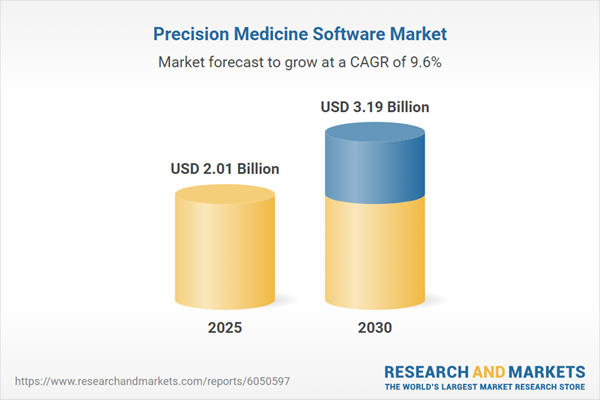The precision medicine software market is estimated to grow at a CAGR of 9.62%, attaining US$3.186 billion by 2030, from US$2.013 billion in 2025.
Precision medicine is a tailored approach to disease prevention and treatment, also known as personalized medicine. It focuses on predicting susceptibility to diseases and preventing disease progression, reducing the trial-and-error nature of drug prescribing and minimizing adverse drug reactions. Precision medicine software serves as a technological platform that provides data-driven, personalized treatment for patients. The rising global incidence of cancer is a significant factor driving the growth of the precision medicine software market during the forecast period. Precision medicine has crucial applications in cancer treatment by offering personalized therapies to patients. Additionally, the increasing integration of artificial intelligence (AI) into healthcare is another major driver of demand for precision medicine software. Countries worldwide are implementing key policies and strategies to enhance the development and integration of AI within the healthcare sector.
Precision medicine is a tailored approach to disease prevention and treatment, also known as personalized medicine. It focuses on predicting susceptibility to diseases and preventing disease progression, reducing the trial-and-error nature of drug prescribing and minimizing adverse drug reactions. Precision medicine software serves as a technological platform that provides data-driven, personalized treatment for patients. The rising global incidence of cancer is a significant factor driving the growth of the precision medicine software market during the forecast period. Precision medicine has crucial applications in cancer treatment by offering personalized therapies to patients. Additionally, the increasing integration of artificial intelligence (AI) into healthcare is another major driver of demand for precision medicine software. Countries worldwide are implementing key policies and strategies to enhance the development and integration of AI within the healthcare sector.
Drivers of the Precision Medicine Software Market:
- Advancements in Global AI Technology: The rapid advancement of artificial intelligence technologies is a primary factor fueling the expansion of the precision medicine software market. The AI technology sector has seen substantial growth, driven by innovations in technology. Governments in countries such as the USA, Canada, and India have introduced various policies and initiatives to promote AI development, particularly in healthcare.
Geographical Trends Shaping the Precision Medicine Software Market:
- Significant Growth in North America: The North American region is expected to hold a substantial share of the precision medicine software market during the forecast period. Countries like the USA and Canada have implemented key strategies to incorporate artificial intelligence into their healthcare systems. The increasing prevalence of chronic diseases, including cancer, further drives demand for precision medicine technologies.
Reasons for buying this report:
- Insightful Analysis: Gain detailed market insights covering major as well as emerging geographical regions, focusing on customer segments, government policies and socio-economic factors, consumer preferences, industry verticals, other sub-segments.
- Competitive Landscape: Understand the strategic maneuvers employed by key players globally to understand possible market penetration with the correct strategy.
- Market Drivers & Future Trends: Explore the dynamic factors and pivotal market trends and how they will shape up future market developments.
- Actionable Recommendations: Utilize the insights to exercise strategic decision to uncover new business streams and revenues in a dynamic environment.
- Caters to a Wide Audience: Beneficial and cost-effective for startups, research institutions, consultants, SMEs, and large enterprises.
What do businesses use our reports for?
Industry and Market Insights, Opportunity Assessment, Product Demand Forecasting, Market Entry Strategy, Geographical Expansion, Capital Investment Decisions, Regulatory Framework & Implications, New Product Development, Competitive Intelligence.Report Coverage:
- Historical data & forecasts from 2022 to 2030
- Growth Opportunities, Challenges, Supply Chain Outlook, Regulatory Framework, Customer Behaviour, and Trend Analysis
- Competitive Positioning, Strategies, and Market Share Analysis
- Revenue Growth and Forecast Assessment of segments and regions including countries
- Company Profiling (Strategies, Products, Financial Information, and Key Developments among others)
The Precision Medicine Software Market is segmented and analyzed as follows:
- By Deployment
- Cloud
- On-Premise
- By Application
- Oncology
- Central Nervous System
- Immunology
- Cardiovascular
- Others
- By End User
- Hospitals and Clinics
- Pharmaceutical Research Institute
- Others
- By Geography
- North America
- USA
- Canada
- Mexico
- South America
- Brazil
- Argentina
- Others
- Europe
- Germany
- Spain
- United Kingdom
- France
- Italy
- Others
- Middle East and Africa
- Saudi Arabia
- UAE
- Others
- Asia Pacific
- China
- Japan
- Australia
- India
- Indonesia
- Thailand
- Others
- North America
Table of Contents
1. INTRODUCTION
2. RESEARCH METHODOLOGY
3. EXECUTIVE SUMMARY
4. MARKET DYNAMICS
5. PRECISION MEDICINE SOFTWARE MARKET BY DEPLOYMENT
6. PRECISION MEDICINE SOFTWARE MARKET BY APPLICATIONS
7. PRECISION MEDICINE SOFTWARE MARKET BY END-USER
8. PRECISION MEDICINE SOFTWARE MARKET BY GEOGRAPHY
9. COMPETITIVE ENVIRONMENT AND ANALYSIS
10. COMPANY PROFILES
Companies Mentioned
- Accenture
- Wipro
- Intel
- GenomOncology LLC
- Precision Medicine Group, LLC.
- Tempus
- Genomind
- Syapse Holdings, Inc.
- Foundation Medicine, Inc.
- 2bPrecise
- Koninklijke Philips N.V
- Cision US Inc.
- Genedata AG
- Ariel Precision Medicine
- Integrate.AI Inc
Methodology

LOADING...
Table Information
| Report Attribute | Details |
|---|---|
| No. of Pages | 145 |
| Published | January 2025 |
| Forecast Period | 2025 - 2030 |
| Estimated Market Value ( USD | $ 2.01 Billion |
| Forecasted Market Value ( USD | $ 3.19 Billion |
| Compound Annual Growth Rate | 9.6% |
| Regions Covered | Global |
| No. of Companies Mentioned | 15 |









